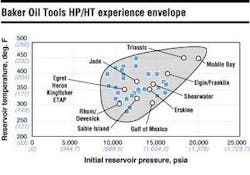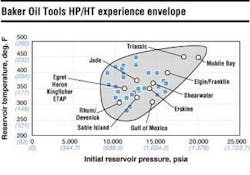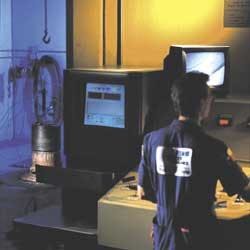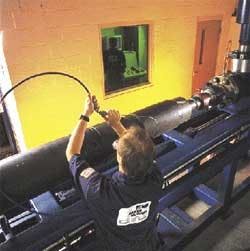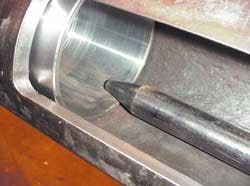Systems approach key to "managing the extreme" on Shearwater, Sable Island HP/HT projects
By Walt Chapman & Don Ingvardsen, Baker Oil Tools
The number and scope of offshore high-pressure/high-temperature (HP/HT) projects is growing rapidly, and so is the need for expertise and resources to meet the challenges of drilling and completion in this demanding environment. As the earlier threshold of 10,000 psi at 300°F (690 bar at 150°C) gives way to 20,000 psi at 450°F (1,379 bar at 232°C), failure cannot be tolerated.
Baker Oil Tools has leveraged its experience in this area to develop a systems approach to HP/HT completion operations that is proving beneficial to both operator and service company. The approach is based on a spirit of partnership between the operator and service company, a willingness to learn from past successes and failures and to share that learning, and a commitment to adhere to a detailed process of managing each project. Shell's Shearwater project in the North Sea and the Sable Offshore Energy Project off the east coast of Nova Scotia provide excellent examples of what can be achieved by following a systems approach.
Shearwater development
The Shearwater Field, operated by Shell Expro, is a gas condensate reservoir located 207 km east of Aberdeen, in the central North Sea. The field consists of the main block and the northwest block. The main block consists of two strata, the high connectivity Fulmar and the underlying Pentland. The hydrocarbon-bearing reservoir lies 16,000 ft beneath the seabed and has combined pressure and temperature conditions of 15,000 psi at 380°F (1,034 bar at 193°C). Based on the nature of the reservoir, it was necessary to drill and complete all development wells before production could start. The contract was awarded to provide completion design, equipment and services for the development, including packers, safety systems, flow control and liner hanger systems. Given the reservoir conditions and the tremendous loads to which the completion string would be subjected, special steps were required to prevent problems such as tubing or casing failure that could cause loss of control of a highly volatile well.
To minimize the risk associated with this project, both operator and service provider agreed to jointly accept and implement a systematic approach designed to ensure flawless execution through all phases of the project. Pre-project stra-tegy meetings were held to reach a consensus on how the project would be managed. These meetings gave both partners the opportunity to define and voice clear expectations of the desired results. Through these meetings, the need for a detailed, systematic project management process was realized and addressed.
Four areas of concern and discipline were identified as critical success factors essential for the successful conception and deployment of high-profile HP/HT developments.
Timing
Experience has shown that for the optimum HP/HT completion system to be designed, engineered, manufactured, and successfully deployed, a substantial period of time must be allocated to all phases of the project. Products required for critical environment completions cannot be planned and must be ordered on a case-by-case basis. This factor has shown that discussions between the oper-ator and the provider need to take place at the inception of the potential project. Twelve to 18 months of pre-planning are typical for projects of this type. We have also learned that assigning a project manager in the early stages helps ensure consistent communication throughout the life of the development. A single point of contact between the customer and the service company eliminates many questions during the process of a project. These project managers must be empowered to make critical decisions that have the backing of their respective companies, and must be able to coordinate all aspects of the project, including engineering, marketing, manufacturing, and quality assurance (QA).
Quality assurance
The operator and the service provider must establish clear and concise quality plans. These plans are customized arrangements to suit specific circumstances. No processes are more critical than QA and quality control (QC). The creation and strict adherence to a specific QA plan and QC procedures by both parties is the foundation for project success. In many cases, third-party representatives may need to act as monitors to assure that both operator and service provider are properly represented, and that the quality plan will meet the requirements of the project.
Engineering
The HP/HT environment challenges the boundaries of traditional downhole technology. All safety-critical downhole completion components must be designed and engineered to purpose. Simply upgrading or altering designs that have been successfully deployed in less severe environments will not produce acceptable performance for the demands of an HP/HT environment. The utmost in design principles must be followed. Design safety factors are increasingly important, as the environment becomes more demanding. To assure adherence to these principles, some operators have elected to have all equipment designs reviewed and approved by independent third-party verification groups. This process can be greatly simplified with the creation of an overall project manager at the beginning of the development. Also, a successful run history goes a long way to verify the design principles that a service company uses.
Qualification and testing
Physical qualification and testing of the equipment is a crucial factor. Experience has shown that the most value is delivered when this process is a result of both operator and service company involvement. The qualification and testing of this equipment is among the most stringent ever conducted in the industry, meeting or exceeding industry standards. Exper-ience shows that merely meeting the industry test standards falls short of the requirements for these high profile completions.
Depending on the completion design that is adopted, a unique testing program might need to be considered. In the case of Sable Offshore Energy Inc. (SOEI) an elaborate test program was developed to guarantee a trouble-free completion. The equipment was first evaluated through extensive computer modeling, followed by physical drift test to visualize the equipment running through critical portions of the completion. This exercise showed the importance of the close working relationship needed between the customer and the service company.
Sable development
All goals and accomplishments for drilling and completing the Shearwater development wells were achieved. Additionally, there were many lessons learned that could be applied to improve the execution of future HP/HT projects. When the SOEI awarded its completions contract, it was evident that Baker Oil Tools would get the chance to act on what was learned at Shearwater and institute a new process.
The SOEI-operated Sable Island Project is located approximately 200 km off the east coast of mainland Nova Scotia, in water depths 65 to 262 ft. The six fields identified as suitable for development in this project are Venture, South Venture, Thebaud, North Triumph, Glenelg and Alma. Venture, Thebaud, and North Triumph were developed during Tier 1 of the completion schedule. South Venture, Glenelg, and Alma will be included in the Tier 2 completion program. The Sable Island fields are expected to produce 400 MMcf/d of gas a day during the 25-year life of the reservoir, with the first year of production processing more than 130 bcf of natural gas. Current production yields an average of 550 MMcf/d of sales gas per day and 20,000 b/d of natural gas liquids. The harsh characteristics of this reservoir
Clear-cut game plan
The first activity was a clarification meeting between the critical players on the project. This two-day meeting, however grueling it might have been, produced a clear-cut game plan. The lines of communication were drawn, the expectations of the customer and service company were detailed, and the partnership was cemented. This meeting resolved such issues as design criteria, equipment testing, quality assurance plans, third-party inspection and design review, project reporting, and documentation. Many times throughout the project, the minutes of that meeting were reviewed, and resolutions that were agreed on early in the project helped to keep both parties focused.
Pursuant to the contract, a project coordinator was named who was approved by SOEI. During the two-day clarification meeting, this person
Instrumental to the success
Focusing on critical success factors was instrumental to the success of the Shearwater and Sable Island development projects as follows:
• Equipment completed ahead of schedule and shipped on time
• Zero findings during design audits
• Developed Best Practice template for design and project management
• 5,500 design and testing man-hours.
High quality of services and support earned four Superior Performance awards from the Shell Shearwater Team as related to: Completion Design and Installation, Development and Supply of HP/HT Safety Valves, Development and Supply of HP/HT Packer, and Development and Supply of Flow Control Systems.
The Sable Island project helped place the Scotian Shelf as a major player in the North American natural gas industry and will yield long-term benefits for Nova Scotia and Canada.
Post completion review
At the completion of the development project, a post completion review to further evaluate performance was conducted. During the runs of packers, safety valves, liner hangers, and flow control equipment, an unprecedented zero non-productive time was realized. With the cost of completing a well in these environments approaching $200,000 to $300,000 a day, this accomplishment was considered of great value.
As the HP/HT arena grows, the critical success factors will become standard practice rather than special arrangements for special projects. Global demand for these high-profile completions will demand that the products necessary to complete the wells be of the highest standard. Ultimately, the goal is to reduce the risk and asset development cost. The willingness of a combined effort to form a tight partnership with dedicated engineering support, focused project management, precise product training, and highly skilled deployment is a key to success.
